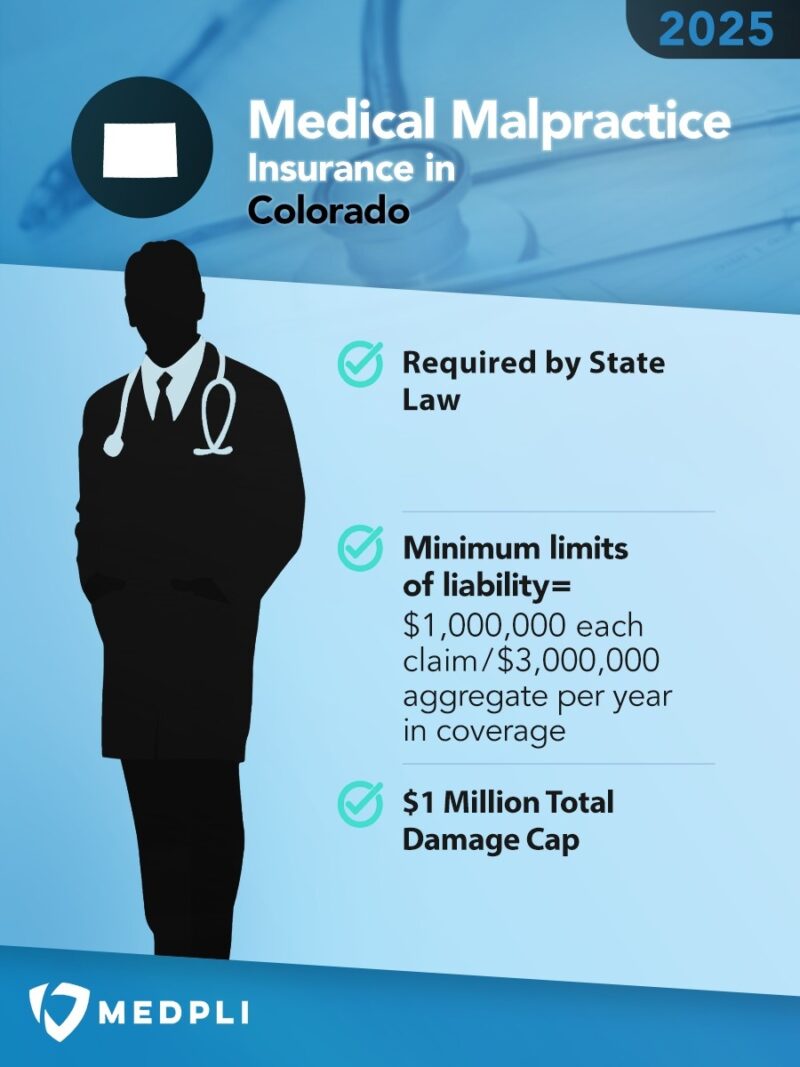Top 5 Malpractice Insurance Carriers in Colorado
We recommend carriers with an AM Best “A” or higher rating. An A-rating indicates financial strength, long-term solvency, and an established history of protecting Colorado physicians.

2025 Colorado Malpractice Insurance Rates by Specialty
These rate estimates are for informational purposes only and are based on the CO standard limits of $1,000,000 for Each Claim / $3,000,000 Aggregate per year in coverage.
Quotes require a completed application and underwriter approval. Contact us for a custom estimate if you don’t see your specialty.
| Specialty | 2025 Annual Premium |
2025 Tail Premium |
|---|---|---|
| Anesthesiology | $18,000 | $36,000 |
| Cardiovascular Disease– Minor Surgery | $20,000 | $40,000 |
| Dermatology– No Surgery | $9,000 | $18,000 |
| Emergency Medicine | $28,000 | $56,000 |
| Family Practice– No Surgery | $12,000 | $24,000 |
| Gastroenterology– No Surgery | $15,000 | $30,000 |
| General Practice– No Surgery | $12,000 |
$24,000 |
| General Surgery | $44,000 | $88,000 |
| Internal Medicine– No Surgery | $12,000 | $24,000 |
| Neurology– No Surgery | $14,000 | $28,000 |
| Obstetrics and Gynecology– Major Surgery | $55,000 | $110,000 |
| Occupational Medicine | $8,000 | $16,000 |
| Ophthalmology– No Surgery | $8,000 | $16,000 |
| Orthopedic Surgery– No Spine | $35,000 | $70,000 |
| Pathology– No Surgery | $10,000 | $20,000 |
| Pediatrics– No Surgery | $11,000 | $22,000 |
| Pulmonary Disease– No Surgery | $16,000 | $32,000 |
| Psychiatry | $7,000 | $14,000 |
| Radiology – Diagnostic | $18,000 | $36,000 |
Have a question? Get fast answers from a U.S.-based MEDPLI agent. Call 1-800-969-1339 or email info@medpli.com.
Colorado Medical Malpractice Payouts From 2015-2023
Types of Professional Liability Insurance for Colorado Physicians
Physicians in Colorado can choose between these two primary types of medical malpractice insurance:

- Provides coverage for incidents that occurred during the policy period IF the claim is filed while the policy is still active. If a claim is filed after the policy ends, that claim is NOT covered.
- Typically, it offers lower premiums at the start of the policy, but rates increase yearly as the policy matures.
- Physicians need to obtain tail insurance coverage when a claims-made policy ends to ensure protection against future claims related to incidents that occurred during the policy period. Tail insurance premiums require a one-time cash payment equal to approximately 200% of the claims-made policy annual premium.

- Provides coverage for incidents that occurred during the policy period, regardless of when a claim is reported to the carrier.
- Typically, it offers more costly premiums at the start of the policy, but the rate stays constant for the entire policy length.
- Physicians do not need tail coverage when an occurrence policy ends.
In 2023, Colorado physicians were held liable for 73 medical malpractice payouts.
- Average Payout: $445,246
- Total Payout: $32,503,000
(Source: National Practitioner Data Bank)
Does Colorado Have Damage Caps for Medical Malpractice Lawsuits?
In June 2024, Colorado passed House Bill 1472, which will go into effect on January 1, 2025. Under the new law, the wrongful death damage cap will increase to $1.575 million over five years, and for medical malpractice lawsuits, the non-economic damage cap will increase from $300,000 to $875,000. After 2029, inflation-based adjustments will occur every two years.
Colorado also enforces a total damages cap of $1 million for aggregate economic and non-economic losses.
Colorado Statute of Limitations for Medical Malpractice Claims
According to Colorado Statute § 13-80-102.5, an action for medical malpractice damages shall be filed within:
- Two years of the injury or discovery of the injury.
Exceptions:
- If a foreign object is left inside the claimant’s body, the 2-year limitation begins upon discovery of the object.
- If a defendant knowingly conceals his/her wrongful conduct, the 2-year limitation begins upon discovery of the negligence.
- If a minor is the victim of malpractice at any age younger than 6 years old, the limitation is extended until his/her 8th birthday.
- For cases of continual treatment, the limitations may not begin until treatment with the provider ends.
Why Colorado Doctors Partner with MEDPLI
We exclusively broker medical malpractice insurance, focusing daily on making the professional liability process less burdensome and expensive for doctors.
With MEDPLI, Colorado physicians:
MEDPLI helps doctors in every specialty.
Whether you’re an orthopedic surgeon in Denver or an emergency physician in Aspen, MEDPLI will provide you with premier coverage at a competitive rate. Call 800-969-1339 or Request a Quote.





